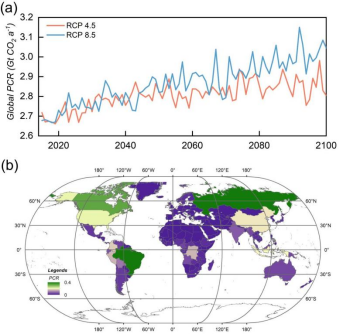The Enhanced Rock Weathering (ERW) strategy has gained rapid attention in recent years as a significant technology for atmosphere CO2 removal. Due to the rapid kinetic characteristics of carbonate, the Enhanced Carbonate Weathering (ECW) strategy has become another key way for the development of ERW. However, there is currently a lack of systematic quantitative assessments regarding the potential of CO2 removal, costs, and the carbon footprint for the application of ECW. Additionally, the stability of carbon sequestration and its potential environmental impacts have not been thoroughly explored.
In this context, a research team led by Professor LIU Zaihua at the Institute of Geochemistry of Chinese Academy of Sciences, in collaboration with Southwest University, has quantified the global carbon sequestration potential, costs, and carbon footprint of ECW by using a carbonate dissolution equilibrium model and Life Cycle Assessment (LCA) within the framework of the Earth System Model (CMIP 6). The results indicate that under the RCP 4.5 and RCP 8.5 climate scenarios, the potential of atmospheric CO2 removal by ECW could reach from 2.66 Gt CO2 a-1 (RCP 4.5) to 2.82 Gt CO2 a-1 (RCP 8.5). And by the end of this century, the cumulative carbon removal from deploying ECW could reach between 241.32 Gt CO2 (RCP 4.5) and 246.64 Gt CO2 (RCP 8.5). This research further reveals that the potential of CO2 removal by ECW in high-latitude regions (such as Russia and Canada) will increase with climate change, rising by as high as 46.6%, making these areas suitable for future ECW applications. In addition, the calculation of the cost and carbon footprints in 11 major countries indicates that the carbon footprint of ECW constitutes about 14.8% to 16.4% of the total carbon removal. This finding suggests that compared to Enhanced Silicate Weathering (ESW), ECW has a lower cost and carbon footprint.
Furthermore, the research emphasizes that it will be a key focus to enhance efficiency of carbon removal for the future large-scale application of the ECW. Thus, this research proposes a new model as enhanced carbonate weathering coupled with aquatic photosynthesis (ECCW). This model highlights the significant role of inland aquatic biological pumps in stabilizing large-scale CO2 removal via ECW. The study suggests that the development of ECW should promote the autochthonous production, transforming DIC under carbonate weathering into autochthonous organic carbon (AOC), which is the key to the geological carbon sink under carbonate weathering. And it indicates that the stability of carbon removal by ECCW may reach 100%.
In addition, the research indicates that as a NETs technology, ECCW also has a series of environmental benefits, including soil amendment, water quality enhancement, and mitigation of ocean acidification, etc.

Figure 1. (a) Global potential of carbon dioxide removal by Enhanced Carbonate Weathering under two Global Climate Model scenarios (RCP4.5 and RCP8.5); (b) Global potential carbon removal by ECW with 2020 as the base(Image by IGCAS).
The study was published in the journal Earth-Science Reviews on April 25.
Contact:
LIU Zaihua
Institute of Geochemistry, Chinese Academy of Sciences
Email: liuzaihua@vip.gyig.ac.cn
(By Prof. LIU Zaihua’s group)